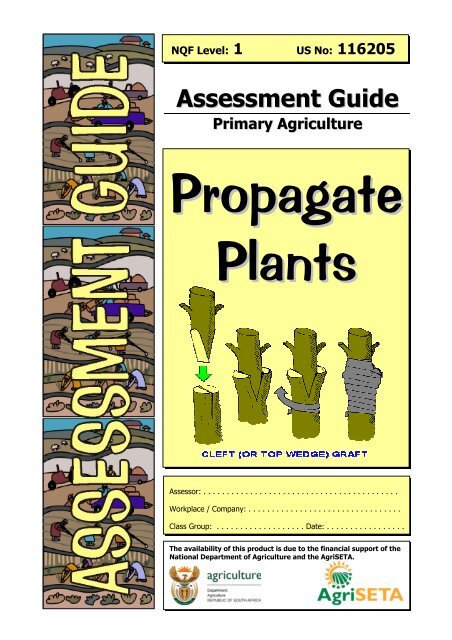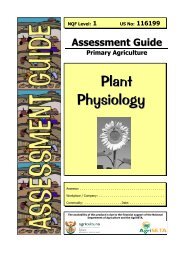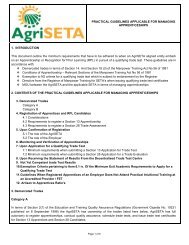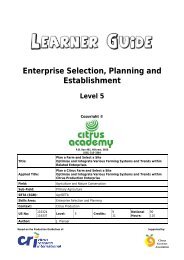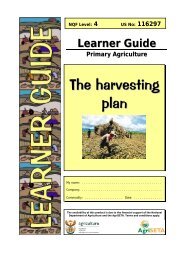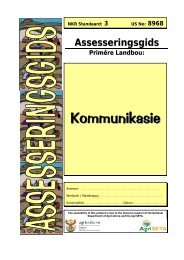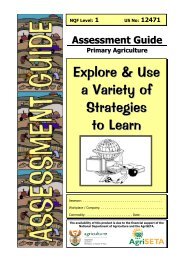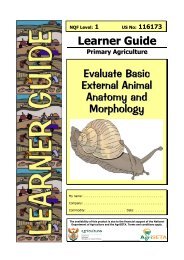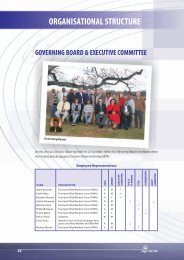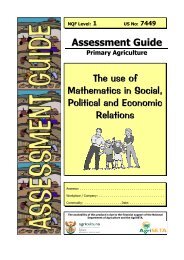Propagate Plants - AgriSETA
Propagate Plants - AgriSETA
Propagate Plants - AgriSETA
You also want an ePaper? Increase the reach of your titles
YUMPU automatically turns print PDFs into web optimized ePapers that Google loves.
<strong>Propagate</strong> <strong>Plants</strong>Primary Agriculture NQF Level 1 Unit Standard No: 1162052Before we start…This assessment guide contains all necessary activitiesand instructions that will enable the assessor andlearner to gather evidence of the learner’s competenceas required by the unit standard. This guide wasdesigned to be used by a trained and accredited assessorwhom is registered to assess this specific unit standardas per the requirements of the <strong>AgriSETA</strong> ETQA.Prior to the delivery of the program the facilitator andassessor must familiarise themselves with content of thisguide, as well as the content of the relevant LearnerWorkbook.The assessor, facilitator and learner must plan the assessment process together, inorder to offer the learner the maximum support, and the opportunity to reflectcompetence.The policies and procedures that are required during the application of thisassessment are available on the website of the <strong>AgriSETA</strong>, names Policies andProcedures for Assessment, and should be strictly adhered to. The assessor mustfamiliarise him/herself with this document before proceeding.This guide provides step-by-step instructions for the assessment process of:Title:<strong>Propagate</strong> plantsThis unit standard is one of the building blocks in the qualifications listed below.Please mark the qualification you are currently assessing, because that will bedetermined by the context of application:Title ID Number NQF Level Credits MarkNational Certificate in Mixed Farming Systems 48971 1 120National Certificate in Pant Production 48972 1 120Please mark the learning program the learners are enrolled in:Please Note:This Unit Standard116205 AssessmentGuide must be readin conjunction withthe generic AssessorGuide as prescribedand published by the<strong>AgriSETA</strong>.US No: 116205 NQF Level: 1 Credits: 5Are you assessing a: Yes NoLearnership?Skills Program?Short Course?Note to Assessor:If you are assessingthis module as part ofa full qualification orlearnership, pleaseensure that you havefamiliarised yourselfwith the content of thequalification.Version: 01 Version Date: July 2006
<strong>Propagate</strong> <strong>Plants</strong>Primary Agriculture NQF Level 1 Unit Standard No: 1162056Model Answer(s):The plants in total darkness would be yellow to white in colour, the stemsmuch longer and thinner than the plants in the sunshine. The plants in thesunshine should weigh more than the plants in the darkness, due tophotosynthesis. Students should thus understand the importance of light inphotosynthesis and thus growth and development. Also refer to paragraph1.1 “Light”, in the Learner Guide, p10.4. Take 10 seedlings of any crop. Get two containers with a capacity of 5-litre andfill it with sand. Plant five seedlings in one container and the other five in theother container. Water regularly for a week. After a week, water the onecontainer every day and the other one every third day (in summer) or fifth day(in winter). After two weeks, compare the growth and health of the two sets ofplants. Write down how water stress affected the growth and health of theplants.Model Answer(s):The dry treatment plants should be wilted and show poor growth. Studentsshould have some understanding of the importance of water for growth ofplants and that water in deficit as well as excess can be detrimental to theplant. Also refer to paragraph 1.1 “Water”, in the Learner Guide, p10.5. Make two growing containers from 2-litre plastic cool drink bottles and fill it withsoil from the field. Plant one seedling (any crop) per container and waterregularly. Cover the one seedling and container with the bottom of another cooldrink bottle, while leaving the other seedling open. After five days, compare thehealth of the two seedlings. Also write down the important gasses needed bycrops for growth and development.Model Answer(s):The plant in the covered container should show poor growth due to a lack ofCO 2 for photosynthesis. Another important gas is O 2 . Also refer to paragraph1.1 “Air”, in the Learner Guide, p10.6. Take two seedlings of any crop. Plant them in separate containers filled withsand. Add two tablespoons of LAN (28% N) to one of the containers and nothingto the other. Apply the same amount over the next three weeks. After fourweeks, compare the colour of the two plants. What is the reason for the colourdifference?Model Answer(s):The plant without LAN should be yellow in colour and might also be smaller insize. This illustrates that plants do not only need water, space and light andthe right temperature, but also food = nutrients. Also refer to paragraph 1.1“Nutrients”, in the Learner Guide, p10.Version: 01 Version Date: July 2006
<strong>Propagate</strong> <strong>Plants</strong>Primary Agriculture NQF Level 1 Unit Standard No: 11620577. Go outside and look at the flower garden. Are all the different flower speciesflowering at the same time? Now think of five crop species (growing in the sameseason) and indicate how long does it take for each of them before theyflower/are harvest ready.Model Answer(s):Sunflower – within 3-4 months. Maize as short as 4 months but can be a longas 6 months. Tobacco as long as 8 months. Etc. Also refer to paragraph 1.1“Time”, in the Learner Guide, p10.8. Take a petri dish filled with agar. Open the dish and press your fingers on theagar as if you are making fingerprints. Now close the dish and mark your nameon it clearly with a permanent marker. Now put the dishes in a warm spot in theclassroom. After a day or two, look at the petri dishes again. What happenedwhere you pressed your fingertips? Now write a short paragraph on theimportance of hygiene in handling propagation material.Model Answer(s):Where the learners have touched the agar, fungal growth would haveappeared. This show the importance of washing the hands before handlingpropagation material to prevent the spread of germs form one place toanother. Also refer to paragraph 1.2, in the Learner Guide, p11.My Notes …. . . . . . . . . . . . . . . . . . . . . . . . . . . . . . . . . . . . . . . . . . . . . . . . . . . . . . . . . . . . . . . . . . . . . . . . . . . . . . . . . . .. . . . . . . . . . . . . . . . . . . . . . . . . . . . . . . . . . . . . . . . . . . . . . . . . . . . . . . . . . . . . . . . . . . . . . . . . . . . . . . . . . .. . . . . . . . . . . . . . . . . . . . . . . . . . . . . . . . . . . . . . . . . . . . . . . . . . . . . . . . . . . . . . . . . . . . . . . . . . . . . . . . . . .. . . . . . . . . . . . . . . . . . . . . . . . . . . . . . . . . . . . . . . . . . . . . . . . . . . . . . . . . . . . . . . . . . . . . . . . . . . . . . . . . . .. . . . . . . . . . . . . . . . . . . . . . . . . . . . . . . . . . . . . . . . . . . . . . . . . . . . . . . . . . . . . . . . . . . . . . . . . . . . . . . . . . .. . . . . . . . . . . . . . . . . . . . . . . . . . . . . . . . . . . . . . . . . . . . . . . . . . . . . . . . . . . . . . . . . . . . . . . . . . . . . . . . . . .. . . . . . . . . . . . . . . . . . . . . . . . . . . . . . . . . . . . . . . . . . . . . . . . . . . . . . . . . . . . . . . . . . . . . . . . . . . . . . . . . . .. . . . . . . . . . . . . . . . . . . . . . . . . . . . . . . . . . . . . . . . . . . . . . . . . . . . . . . . . . . . . . . . . . . . . . . . . . . . . . . . . . .. . . . . . . . . . . . . . . . . . . . . . . . . . . . . . . . . . . . . . . . . . . . . . . . . . . . . . . . . . . . . . . . . . . . . . . . . . . . . . . . . . .. . . . . . . . . . . . . . . . . . . . . . . . . . . . . . . . . . . . . . . . . . . . . . . . . . . . . . . . . . . . . . . . . . . . . . . . . . . . . . . . . . .. . . . . . . . . . . . . . . . . . . . . . . . . . . . . . . . . . . . . . . . . . . . . . . . . . . . . . . . . . . . . . . . . . . . . . . . . . . . . . . . . . .. . . . . . . . . . . . . . . . . . . . . . . . . . . . . . . . . . . . . . . . . . . . . . . . . . . . . . . . . . . . . . . . . . . . . . . . . . . . . . . . . . .. . . . . . . . . . . . . . . . . . . . . . . . . . . . . . . . . . . . . . . . . . . . . . . . . . . . . . . . . . . . . . . . . . . . . . . . . . . . . . . . . . .. . . . . . . . . . . . . . . . . . . . . . . . . . . . . . . . . . . . . . . . . . . . . . . . . . . . . . . . . . . . . . . . . . . . . . . . . . . . . . . . . . .. . . . . . . . . . . . . . . . . . . . . . . . . . . . . . . . . . . . . . . . . . . . . . . . . . . . . . . . . . . . . . . . . . . . . . . . . . . . . . . . . . .Version: 01 Version Date: July 2006
<strong>Propagate</strong> <strong>Plants</strong>Primary Agriculture NQF Level 1 Unit Standard No: 11620582.1Instructions to Learner:Explore and discussSO 2 AC 1-4Learner Workbook: Page 8 - 9 Facilitator Guide: Page 13 - 141. Explore and Find out: Collect two stems each of the following: herbaceousplants, soft wood and hard wood plants. Dry the stems or take photos and pasteon a piece of paper. Name the plant species and say if it is herbaceous, softwood or hard wood plant.Model Answer(s):Herbaceous plants like tomatoes, sweet potatoes, pelargonium etc.Softwood from young growth of woody plant, mostly for ornamental treesand shrubs and some fruit trees.Harwood from deciduous trees like grape vines, apples and figs duringwinter or early spring.2. Discuss in your group: Some crops like an apple or a rose can grow fromseed or a cutting. Which of the two propagation methods would you recommendfor propagating apples? Write down what you discussed.Model Answer(s):Refer to Figure 2.1 in the Learner Guide, p13.Should use above-mentioned information to state that cuttings rather thanseeds would be use, since it gives faster rise to a crop and secondly it is anidentical copy of the mother parent.3. Discuss in your group: We grow vegetables like tomatoes, pumpkins andbeans from seed. Why do you think do we do this? Can these vegetables growfrom e.g. cuttings?Model Answer(s):Refer to Figure 2.1 in the Learner Guide, p13.Seeds are most often used since we need a large population of the crop to besuccessful and making cuttings would be too expensive and not alwayssuccessful. The seed for propagation is usually of a high genetic purityresulting in desired crops, which makes cloning unnecessary. Yes cuttings canbe made.Version: 01 Version Date: July 2006
<strong>Propagate</strong> <strong>Plants</strong>Primary Agriculture NQF Level 1 Unit Standard No: 11620594. Get at least 20 bean seeds. Divide the seed in four batches. Place one batchbetween moist paper towels and place the towels on a saucer and place itsomewhere warm in the room. Take the second batch and also place it betweenmoist paper towels, but put it in a ziplock plastic bag and remove all the airbefore closing it. Place these seeds next to the previous batch of seeds. Take thenext batch of seeds and place it between dry paper towels on a saucer and placeit next to the previous two batches. Take the last batch of seeds, place itbetween moist paper towels on a saucer and place it in the refrigerator. After aweek, inspect the seeds and write down your observations. Which conditionswere the best for germinating the seeds?Model Answer(s):Seeds with moist paper at room temperature would show the bestgermination. The seed with no water, would not have germinated at all. Theseed in the ziplock bag would have germinated but also rotted and the seedin the refrigerator would most probably not have germinated or germinationwould be very poor. Also refer to paragraph 2.2.1 (water, oxygen, heat, light)in the Learner Guide, p15 - 16.5. Cut a 2-litre cold drink bottle open about 15cm from the base. Pierce 3holes in the top of the bottle. Put the cap of the bottle on. Put soil in the bottompart & place a seed in the soil. Water the soil. Put the top of the bottle over thebottom part. Place your bottle in direct sunlight & see what happens… Write areport about it.Model Answer(s):Observations should include the time it took to germinate. What part of theplant could be seen first and general growth of the seedling. Should take inaccount all the previous information on the factors affecting germination andgrowth.My Notes …. . . . . . . . . . . . . . . . . . . . . . . . . . . . . . . . . . . . . . . . . . . . . . . . . . . . . . . . . . . . . . . . . . . . . . . . . . . . . . . . . . .. . . . . . . . . . . . . . . . . . . . . . . . . . . . . . . . . . . . . . . . . . . . . . . . . . . . . . . . . . . . . . . . . . . . . . . . . . . . . . . . . . .. . . . . . . . . . . . . . . . . . . . . . . . . . . . . . . . . . . . . . . . . . . . . . . . . . . . . . . . . . . . . . . . . . . . . . . . . . . . . . . . . . .. . . . . . . . . . . . . . . . . . . . . . . . . . . . . . . . . . . . . . . . . . . . . . . . . . . . . . . . . . . . . . . . . . . . . . . . . . . . . . . . . . .. . . . . . . . . . . . . . . . . . . . . . . . . . . . . . . . . . . . . . . . . . . . . . . . . . . . . . . . . . . . . . . . . . . . . . . . . . . . . . . . . . .. . . . . . . . . . . . . . . . . . . . . . . . . . . . . . . . . . . . . . . . . . . . . . . . . . . . . . . . . . . . . . . . . . . . . . . . . . . . . . . . . . .. . . . . . . . . . . . . . . . . . . . . . . . . . . . . . . . . . . . . . . . . . . . . . . . . . . . . . . . . . . . . . . . . . . . . . . . . . . . . . . . . . .. . . . . . . . . . . . . . . . . . . . . . . . . . . . . . . . . . . . . . . . . . . . . . . . . . . . . . . . . . . . . . . . . . . . . . . . . . . . . . . . . . .. . . . . . . . . . . . . . . . . . . . . . . . . . . . . . . . . . . . . . . . . . . . . . . . . . . . . . . . . . . . . . . . . . . . . . . . . . . . . . . . . . .Version: 01 Version Date: July 2006
<strong>Propagate</strong> <strong>Plants</strong>Primary Agriculture NQF Level 1 Unit Standard No: 116205103.1SO 3 & 4Instructions to Learner:Propagation Experiment.NOTE: Learners should be supplied with sand, a heavy claysoil and a sand organic material mixture.Learner Workbook: Page 10 - 11 Facilitator Guide: Page 15 - 171. Take some large seeds like beans or maize in plant in different growing mediaavailable. Take small seeds like tomato and carrots and plant in different media.Write a report on the results. Did some plants grow better in one media thananother?2. Take care off the plants (propagated in previous activity) till harvesting and writea step-by-step report on how you managed the crop(s).3. Go outside and take stem cuttings from a tomato plant, a rose scrub and a figtree. Now make illustrations (or photos) and notes of these cuttings in your bookfor future reference.Model Answer(s):Stem cuttings already have buds that can sprout to form shoots and all theyneed is to form roots. Different kinds of stem cuttings can be made:, From herbaceous plants like tomatoes, sweet potatoes, pelargonium etc.can be basal cuttings (taken from the lower part of a shoot with five toseven nodes) or terminal cuttings taken from the tip of the shoot, alsowith five to seven nodes. Remove the bottom leaves, dip basal end ofcutting into rooting hormone and plant in tray or pot containing moistgrowing medium. Put container on mistbed., Softwood cuttings taken from young growth of woody plant, mostly forornamental trees and shrubs and some fruit trees. Take cutting from tip ofsoft shoot, remove the bottom leaves, insert base in rooting hormone andplant as above., Harwood cuttings are mostly taken from deciduous trees like grape vines,apples and figs during winter or early spring. Tip or basal cuttings of 15 to30 cm can be made and treated as above., The cuttings can also be planted directly into the medium in the mistbedor the container with the cuttings can be placed on the mistbed.Version: 01 Version Date: July 2006
<strong>Propagate</strong> <strong>Plants</strong>Primary Agriculture NQF Level 1 Unit Standard No: 116205114. Go outside. Make leaf and root cuttings from the material provided. Make notesand illustrations of the procedures in your workbook.Model Answer(s):Leaf cuttings do not have either buds or roots and both are required toform a new plant. In some ornamental plants leaf cuttings can be used toproduce new plants. For African violets and Peperomia whole leaves can beused and for Begonia and Sansevieria, sections of leaves can be used.Root cuttings need to produce buds to form new plants. <strong>Plants</strong> that can bepropagated by means of root cuttings are pear, apple quince and someornamental trees like poplars.Also refer to page 22 in the Learner Guide.5. Go outside and graft the plants provided. Make notes and illustrations of theprocedure in your workbook.Model Answer(s):Grafting is the act of joining parts of separate plant together that will join toform a new plant with unique qualities. The rootstock or stock forms thebottom part of the new plant that bears the root system. The scion or bud isthat part of the combination that will form the upper part of the plant that willbear the flowers and fruit. A scion usually consists of a piece of stem with oneor more buds. When budding is one, the scion is reduced to a single bud witha piece of bark and a thin piece of underlying wood. Also refer to paragraph“Why grafting” on page 24 in the Learner Guide as well as paragraph 3.3, pp24 - 25.6. Go outside and perform ground and air layering on the provided material. Makenotes and illustrations of the procedures in your workbook.Model Answer(s):Refer to paragraph “Layering” on page 22 in the Learner Guide as well asparagraph “Air layering” on page 23.7. Take a few potato tubers. Store it at room temperature in a paper bag with holesin, for four weeks or till sprouts develop. Remove the tubers from the bag andsee if you can identify the leaves and stems of the new potato plants. Make anillustration and notes of what you observed in your workbook. If you have spaceoutside, plant the sprouted tubers at a depth of 5-10 cm and take care of it tillharvest.Model Answer(s):Sprouts consisting of leaves and a stem should be visible. Also say somethingabout the storing conditions to have made this possible i.e. temperature andlack of direct sunlight but in the presence of air.Version: 01 Version Date: July 2006
<strong>Propagate</strong> <strong>Plants</strong>Primary Agriculture NQF Level 1 Unit Standard No: 11620512Assessment Feedback FormComments / RemarksFeedback to learner on assessment:Feedback from learner to assessor:Learner’s Signature:Date:Assessor’s Signature:Date:Version: 01 Version Date: July 2006
<strong>Propagate</strong> <strong>Plants</strong>Primary Agriculture NQF Level 1 Unit Standard No: 11620513Summative Test and Attitude &Attribute EvaluationBefore the knowledge test is undertaken, the learner must be reminded of what isexpected from him / her in terms of summative and reflexive competence. Readand explain to the learner, the Preparation for Your Final Assessment section inthe learner workbook. Learners and assessor should sign off this section toacknowledge that this step was completed.Please set up a knowledge test from the questions given as a guideline to learnersand supply each learner with a test sheet.Supply each report with the following heading:Unit Standard: 116205 NQF Level: 1Learner Name:Questions1. Can you give a simple definitionof what plant propagation is?2. How would you describe thepropagation environment thatyou used to propagate yourplant?3. Did you experience anyproblems during thepropagation? If your answer isyes, then explain them in detail,with possible reasons for theproblems.4. Can you think of any otherproblems that someone whonormally propagates plants hasto beware of?5. Explain what kinds of Hygieneprocedures you applied duringthe propagation processes.Model AnswerIt is making more plants from one plant.Student have to show basic understanding of the soil, space, temp, light,nutrients, air, water, time, open field or tunnel which was used. Give detail on itas indicated in the learner guide.The student can identify a growth factor like water, nutrients, wrongtemperature etc, which was lacking or inadequate. Student should be able togive solutions if applicable, also.Most of the above factors can be monitored (observed at regular intervals) andcontrolled when propagation is done in closed areas. In open land propagationonly water, nutrients, spacing and hygiene can be controlled. Problems canarise if any of the mentioned factors are out of control or does not agree withthe requirements of the specific crop. Problems can, however, also arise if poorquality propagation material is used or if no proper hygiene measures havebeen applied. The only way to handle these problems is to monitor and controlall factors during the propagation process according to the requirements of thecrop.All equipment and tools should be clean and properly sterilized before startingwith the propagation. Disinfectants on the market are, household ‘Jik’, chlorineused for swimming pools, ‘Sporekill’ and ‘Prasin. Apart from personal hygiene,workers must wash their hands and preferably wear sterilized rubber gloveswhen working with growing media and propagation material. The reason beingthat the equipment and propagation material can be infected with fungi,bacteria or viruses that can cause diseases and eventually affect the productionof the crop. When using seed as propagation material, the seed can besterilized or treated with fungicides.Version: 01 Version Date: July 2006
<strong>Propagate</strong> <strong>Plants</strong>Primary Agriculture NQF Level 1 Unit Standard No: 116205146. Explain how you prepared thepropagation material andpropagation media before youstarted with an experiment.7. Say whether the propagationmaterial that you used is sexualor a-sexual. Explain how youknew this.8. Explain what type of growingmedia you used, and why youused it.The propagation material should be free of diseases, thus it can be disinfectedand thereafter treated with chemicals to prevent future contamination. Dippingcuttings into growth hormones can also be mentioned.For better results, the medium should be sterilized before use. This will get ridof unwanted insects, diseases and weeds. Student can also say somethingabout incorporating fertilizers and other amendments into the media to improvegermination and growth.Refer to Figure 2.1 on page 12 in the Learner Guide.Examples can be : a combination of 1/3 sterilized soil, 1/3 sand or vermiculiteor perlite, and 1/3 peat moss. It should be fine and uniform, yet well aeratedand loose. It should be free of insects, disease organisms, and weed seeds. Itshould also be of low fertility or total soluble salts and capable of holding andmoving moisture by capillary action.Sphagnum peat moss or decomposed pine bark and vermiculite, both of whichare generally free of diseases, weed seeds, and insects can also be used. Theingredients are also readily available, easy to handle, lightweight, and produceuniform plant growth. These mixes have little fertility, so seedlings must bewatered with a diluted fertilizer solution soon after they emerge. The use ofgarden soil by itself as a germination medium is not recommended; it is notsterile, is too heavy, and might not drain well.For better results, the germination medium should be sterilized. Ready-to-use,sterilized media are available on the market but if you are making up your ownmixtures and not using sterilized components, it is advisable to steam-sterilizethe mixture before use.9. If you had to explain to a friendor fellow worker what kind ofroutine duties someone whoworks in a propagationenvironment would do, whatwould you say?10. Give a step-by-step account of agrafting procedure.11. On what basis would you chooseto propagate plants with seed?12. On what basis would you chooseto propagate plants asexually?Timeous ordering of propagation material and all other consumables usedduring propagation.Making sure all equipment and tools used during propagation are in workingorder and clean.Preparing the propagation material in such a way as to prevent it beingcontaminated by diseases.Preparing of growing media for tunnel production or seedbed preparation forfield establishment.Establishing the propagation materialCaring for the resulting crop in terms of water, nutrients, diseases, insects andweeds.For grafting the scion and rootstock should be of the same thickness to makesure that the inner part of the bark of the scion, (called the cambium) fits thecambium of the rootstock. There are a different ways to for making the cuts,but the method where the rootstock is split using a grafting knife, the scion iscut into a wedge and slipped into the split, is a good method for beginners. Thetwo parts are then tied tightly together with a grafting strip (plastic) and kept inthe nursery until the bud of the scion has sprouted. To make sure that nowater enters the graft wound, the graft union can also be covered with graftingwax or commercial ‘Tree Seal’.Where exact copies of the parents are not needed for success.Where thousands and ten or even hundred thousand plants per ha should beplanted, making use of seed would be easier and also cheaper. This is usuallydone for field (maize, soybean, wheat etc) and vegetable crops.Usually for perennial plants where making use of asexual material gives exactreplicas of the parent plant and where the plants would also start bearingfruit/flowers at an earlier stage as on plants propagated from seed.Version: 01 Version Date: July 2006
<strong>Propagate</strong> <strong>Plants</strong>Primary Agriculture NQF Level 1 Unit Standard No: 1162051513. What growth factors are neededfor good seed germination?14. Can you identify some cropseeds which need specialtreatment to be able togerminate? Which treatmentscan be applied to improvegermination?15. Can you list some of theequipment used when crops arepropagated by means of seed?Water Most seeds are dry and contain less than 20% water. The first step inthe germination process is the imbibition or absorption of water. Even thoughseeds have great absorbing power due to the nature of their contents, theamount of available water in the germination medium affects the uptake ofwater. An adequate, continuous supply of water is important to ensuregermination. Once the germination process has begun, a dry period will causethe death of the embryo.Oxygen In all viable (live) seed, respiration takes place. The respiration rate instored seed is very low, but some oxygen is required. The respiration rateincreases during germination; therefore, the medium in which the seeds areplaced should be loose and well aerated. If the oxygen supply duringgermination is limited or reduced, germination can be severely retarded orinhibited.Heat A favourable temperature is another important requirement ofgermination. It not only affects the germination percentage, but also the rate ofgermination. Some seeds will germinate over a wide range of temperatures,whereas others require a narrow range. Many seed have minimum, maximum,and optimum temperatures at which they germinate. For example, tomato seedhas a minimum germination temperature of 15ºC and a maximum temperatureof 35ºC, but an optimum germination temperature of about 27ºC. Wheregermination temperatures are listed, they are usually the optimumtemperatures unless otherwise specified. Generally, winter crop seed in generalgerminate at 15ºC to 20ºC while summer crop seed requires a temperature of20ºC to 30ºC.Light is known to stimulate or to inhibit germination of some kinds of seed.The light reaction involved here is a complex process. Seed that have arequirement for light for germination are ageratum, begonia, browallia,impatiens, lettuce, celery and most grasses. Conversely, onion, calendula,centaurea, annual phlox, verbena, and vinca will germinate best in the dark.The seed of most agricultural crops are not specific at all.There are four environmental factors that affect germination: water, oxygen,heat and some seeds also need light. Some seeds will not germinate even ifthey are exposed to the optimum levels of the four conditions mentionedabove. Such seeds are said to be dormant and would need special treatmentsbefore they will germinate like scarification, cold treatment or heattreatment and leaching.Scarification As result of the hard, impenetrable seed coat, some seeds likecotton seed and seed of some legumes cannot take up water for germination.The seeds are therefore called hard-seeded and need to be scarified, byrubbing the seed between two pieces of sand paper, or mixing the seed withcourse sand and shaking the mixture in a closed container until the seed coatsare worn away sufficiently to be able to absorb water.Heat treatment is another method for scarifying impermeable seed coats.The seed is dropped in water with a temperature of between 70ºC and 100ºCand left in the water while allowing it to cool down.Stratification (cold treatment) Seed of peaches, apples and other treesfrom the northern hemisphere, when taken from ripe fruit, will not germinateuntil they have been stratified. During this process the seed is placed in moistsoil or germination medium and left in a fridge at about 4 o C for about threemonths before planting.Leaching Beetroot for example. The fruiting body contains a chemicalcompound which prevents germination. To get rid of this chemical, the seedcan be washed under running tap water for at least 15 minutes.Direct sowing in the field or seedling bed – mechanical planter. Make sure it iscalibrated correctly to ensure the right plant spacing and also to prevent theseeds from getting damaged. Making of seedlings – In nursery – seedling trays,growing media and a seed planter. Seedling trays and growing media should besterilized before use.Version: 01 Version Date: July 2006
<strong>Propagate</strong> <strong>Plants</strong>Primary Agriculture NQF Level 1 Unit Standard No: 1162051616. Can you list some of theequipment used when crops arepropagated by means ofvegetative material?Pruning shears for making cuttingsMistbed for keeping cuttings moist and worm while rooting A mistbed lookslike a table with a box-like top The bottom of the table top is fitted with heatingcables or heating elements with a heat control system (thermostat) A mistingsystem is fitted about 10cm above the table top, The misting system breaks upthe water into very fine droplets that keep the cuttings moist, The system canbe set so that it is turned on every few minutes for a few seconds at a time.Grafting knife for grafting and buddingGrafting strips for tying the scion and rootstock. togetherGrafting wax for covering grafts to limit dehydration and entrance of waterContainers for rooting and planting cuttingsGrowing mediumKnife :A good-quality knife, able to hold a sharp edge, is the key to goodgrafting. Although special grafting and budding knives are desirable, you canuse almost any good pocket-knife. Keep material to sharpen the knife handy.Grafting wax: After the graft is made, some covering must be used to keep itfrom drying out. Either hand wax or brush wax may be used. A hand wax ismost commonly used for home grafting. It is softened by the heat of the handand can be easily applied. Heated waxes may be brushed on, but make surethe wax is not too hot. Heat could damage the tender cambium tissue.Grafting tape: This is a special tape with a cloth backing that decomposesbefore girdling can occur. Tapes may be used for binding grafts where there isnot enough natural pressure. Electrical and masking tapes are also used.Masking tape is suitable where little pressure is required, as in the whip graft.Budding strips: Budding strips are elastic bands. They look like a wide rubberband that has been cut open. Budding strips secure several types of grafts withsmall stocks and scions.Nails:Veneer, bridge and inarching grafts require long, thin nails. Half-inchnails are long enough for most grafts, except for bridge grafting, which mayrequire ¾-inch nails. We often use staples (regular paper staples) in graftingas well.Special grafting toolVersion: 01 Version Date: July 2006
<strong>Propagate</strong> <strong>Plants</strong>Primary Agriculture NQF Level 1 Unit Standard No: 1162051717. Can you list the 10 vegetativepropagation methods and givetwo examples of crops in whicheach method can be used?Stem cuttings: Stem cuttings already have buds than can sprout to formshoots and all they need is to form roots. Different kinds of stem cuttings canbe made: tomatoes, sweet potatoes, pelargonium, grape vines, apples and figsLeaf cuttings: Leaf cuttings do not have either buds or roots and both andboth are require to form a new plant. In some ornamental plants leaf cuttingscan be used to produce new plants. For African violets and Peperomia wholeleaves can be used and for Begonia and Sansevieria, sections of leaves can beused.Root cuttings: Root cuttings need to produce buds to form new plants. <strong>Plants</strong>that can be propagated by means of root cuttings are pear, apple quince andsome ornamental trees like poplars.Ground layering: When making cuttings, the main problem is o keep themmoist until the have developed a root system to supply them with water andnutrients. During the process of layering, the ‘cutting’ remains attached to themother plant until a root system has developedAir layering is basically the same as ground layering, but instead of using theground as rooting place or rooting medium, the severing or ringbarking is doneon a branch higher up in the tree or shrub and a moist growing medium ispositioned around the severed part and covered with a piece of dark, strongplastic to prevent the growing medium to dry out. Roots will develop in thegrowing medium after which the rooted branch can be removed from themother plant and planted.Dividing Bulbs Bulbous plants usually form daughter bulbs or divide duringtheir growing cycle. If we dig them up & divide the bulbs we have manyplants. Bulb scales will also produce bullets if separated from the bulb andtreated as leaf cuttings.Using modified plant organs: Modified plant organs like stem tubers ofpotatoes, rhizomes of ginger, root tubers of sweet potatoes and runners likestrawberry can be used directly as propagation material.Division: <strong>Plants</strong> that grow in multi-stemmed clusters like chives, asparagusand many ornamental plants can be divided. The clusters are merely broken orcut into smaller sections and replanted.Grafting is the act of joining parts of separate plant together that will join toform a new plant with unique qualities. The rootstock or stock forms thebottom part of the new plant that bears the root system. The scion or bud isthat part of the combination that will form the upper part of the plant that willbear the flowers and fruit. Sweet cherry is more commonly grafted ontoMazzard (Prunus avium) or Mahaleb (P. mahaleb) seedlings. For example,quince, genus Cydonia, may be used as a dwarfing rootstock for pear, genusPyrus.For budding, a healthy, swollen bud is cut (with a sharp pruning knife) from thedesired plant. A T-section is cut into the bark of the rootstock and the barklifted at the junction of the two cuts. The bud is then slit into the opened T-cutso that its cambium makes good contact with the cambium of the rootstock. Agrafting strip is used to tie the two parts together.Version: 01 Version Date: July 2006
<strong>Propagate</strong> <strong>Plants</strong>Primary Agriculture NQF Level 1 Unit Standard No: 11620518Assessment Feedback FormComments / RemarksFeedback to learner on assessment and / or overall recommendations and action plan forcompetence:Feedback from learner to assessor:Assessment JudgementYou have been found: Competent Not yet competentin this unit standardLearner’s Signature:Actions to follow: Assessor report to ETQA Learner results and attendancecertification issuedDate:Assessor’s Signature:Date:Moderator’s Signature:Date:Version: 01 Version Date: July 2006


